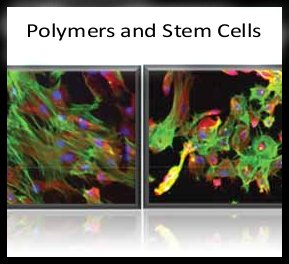Home > Press > Advances in Polymers for Stem Cell Research
 |
Abstract:
The second part of the series "Advances in Polymers for Stem Cell Research" by guest-editor Suwan N. Jayasinghe is now complete and the last articles have just gone online.
Advances in Polymers for Stem Cell Research
Germany | Posted on August 20th, 2012This series aims to give a comprehensive and versatile impression of the interdisciplinary field of Polymers for Stem Cell Research. It brings new insights into how natural and synthetic polymers can be used in conjunctions with stem cells. Some of the best and most famous scientist in this area have contributed and make this series a unique collection of state-of-the-art pieces of research. The series includes reviews and full papers about scaffold design for artificial organs, cell delivery systems, differentiation control and much more.
Read the following articles from the series now for free!
Levenberg and co-workers try to replicate the physicochemical microenvironment observed during the embryonic development by creating morphogenic gradients through the thickness of hydrospun scaffolds. Poly(ε-caprolactone) fibers were loaded with all-trans-retinoic acid (ATRA), and designed to release it at a predetermined rate. The presented results indicate that morphogen gradients can regulate stem cell differentiation patterns.
Both substrate topography and mechanical properties can influence cell behavior. Little is known about the interplay of these two parameters. Reinhart-King and co-workers (Cornell University, Ithaca, USA) present a method to introduce topographical features into polyacrylamide (PA) hydrogel substrates that span a wide range of physiological E values. The scientists find that cells exhibit contact guidance regardless of the stiffness of the substrate.
Sharon Gerecht and co-workers synthesized a dextran-based, biodegradable, temperature-sensitive polymer and tested it as a novel, substrate for nonenzymatic cell detachment. It is found to be compatible for use in endothelial progenitor cell culture as revealed by cell attachment, spreading, proliferation, and phenotype. Because of its complete biodegradability it can directly be used in the culture of stem cells without removing nondegradable polymers.
####
For more information, please click here
Copyright © Wiley-VCH Materials Science Journals
If you have a comment, please Contact us.Issuers of news releases, not 7th Wave, Inc. or Nanotechnology Now, are solely responsible for the accuracy of the content.
| Related News Press |
News and information
![]() Researchers develop molecular qubits that communicate at telecom frequencies October 3rd, 2025
Researchers develop molecular qubits that communicate at telecom frequencies October 3rd, 2025
![]() Next-generation quantum communication October 3rd, 2025
Next-generation quantum communication October 3rd, 2025
![]() "Nanoreactor" cage uses visible light for catalytic and ultra-selective cross-cycloadditions October 3rd, 2025
"Nanoreactor" cage uses visible light for catalytic and ultra-selective cross-cycloadditions October 3rd, 2025
Nanomedicine
![]() New molecular technology targets tumors and simultaneously silences two ‘undruggable’ cancer genes August 8th, 2025
New molecular technology targets tumors and simultaneously silences two ‘undruggable’ cancer genes August 8th, 2025
![]() New imaging approach transforms study of bacterial biofilms August 8th, 2025
New imaging approach transforms study of bacterial biofilms August 8th, 2025
![]() Cambridge chemists discover simple way to build bigger molecules – one carbon at a time June 6th, 2025
Cambridge chemists discover simple way to build bigger molecules – one carbon at a time June 6th, 2025
![]() Electrifying results shed light on graphene foam as a potential material for lab grown cartilage June 6th, 2025
Electrifying results shed light on graphene foam as a potential material for lab grown cartilage June 6th, 2025
Discoveries
![]() Researchers develop molecular qubits that communicate at telecom frequencies October 3rd, 2025
Researchers develop molecular qubits that communicate at telecom frequencies October 3rd, 2025
![]() Next-generation quantum communication October 3rd, 2025
Next-generation quantum communication October 3rd, 2025
![]() "Nanoreactor" cage uses visible light for catalytic and ultra-selective cross-cycloadditions October 3rd, 2025
"Nanoreactor" cage uses visible light for catalytic and ultra-selective cross-cycloadditions October 3rd, 2025
Announcements
![]() Rice membrane extracts lithium from brines with greater speed, less waste October 3rd, 2025
Rice membrane extracts lithium from brines with greater speed, less waste October 3rd, 2025
![]() Researchers develop molecular qubits that communicate at telecom frequencies October 3rd, 2025
Researchers develop molecular qubits that communicate at telecom frequencies October 3rd, 2025
![]() Next-generation quantum communication October 3rd, 2025
Next-generation quantum communication October 3rd, 2025
![]() "Nanoreactor" cage uses visible light for catalytic and ultra-selective cross-cycloadditions October 3rd, 2025
"Nanoreactor" cage uses visible light for catalytic and ultra-selective cross-cycloadditions October 3rd, 2025
|
|
||
|
|
||
| The latest news from around the world, FREE | ||
|
|
||
|
|
||
| Premium Products | ||
|
|
||
|
Only the news you want to read!
Learn More |
||
|
|
||
|
Full-service, expert consulting
Learn More |
||
|
|
||








